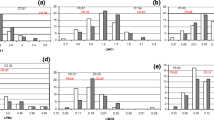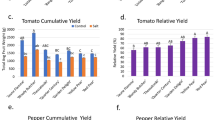Summary
Plants of the salt-sensitiveL. esculentum, the halophytic wild speciesL. pennellii, their F1 hybrids and the interspecific F2 generation were grown in Hoagland's liquid culture containing 100 mM NaCl and 6 mM K+. Analysis of the Na+, Cl- and K+ ions contents of the leaves showed, as observed also in previous studies, that the cultivated parent accumlated more K+ and less Na+ than the wild parent. A total of 117 F2 plants were assayed for 15 electrophoretically detectable isozyme markers which map to nine of the twelve tomato chromosomes. Four loci, all with a similar quantitative effect on Na+ and Cl- uptake, were identified by virtue of their linkage to isozyme markers. Two other loci were found to affect K+ uptake. This study demonstrates the potential value of using genetic markers in order to gain a better understanding of the genetic basis of quantitative traits associated with the response of plants to salinity stress.
Similar content being viewed by others
References
Dixon, W. J., 1983. Description of groups with histograms and analysis of variance. In:W. J. Dixon (Ed.), BMDP statistical software. University of California Press, p. 105–115.
EpsteinE., J. D.Norlyn, D. W.Rush, R. W.Kingsbury, D. B.Kelley, G. A. Cunningham & A. F.Wrona, 1980. Saline culture of crops: a genetic approach. Science 210: 339–404.
GreenwayH. & R.Munns, 1980. Mechanisms of salt tolerance in nonhalophytes. Ann. Rev. Plant Physiol. 31: 149–190.
ShannonM. C., 1984. Breeding, selection and the genetics of salt tolerance. In: R. C.Staples & G. H. Toenniessen (Eds), Salinity tolerance in plants. Strategies for crop improvement. Wiley, New York, p. 231–254.
RushD. W. & E.Epstein, 1981. Comparative studies on sodium, potassium and chloride relations of wild halophytic and domestic salt-sensitive tomato species. Plant Physiol. 68: 1308–1313.
TalM. & M. C.Shannon, 1983. Salt tolerance in the wild relatives of the cultivated tomato: responses ofLycopersicon esculentum, L. cheesmanii, L. peruvianum, Solunam pennellii and F1 hybrids to salinity. Aust. J. Plant Physiol. 10: 109–117.
TanksleyS. D., H.Medina-Filho & C. M.Rick, 1982. Use of naturally-occurring enzyme variation to detect and map genes controlling quantitative traits in an interspecific backcross of tomato. Heredity 49: 11–25.
TanksleyS. D. & F.Loaiza-Figueroa, 1985. Gametophytic self-incompatibility is controlled by a single major locus on chromosome 1 inLycopersicon peruvianum. Proc. Natl.Acad. Sci. USA 82: 5093–5096.
VallejosC. E. & S. D.Tanksley, 1983. Segregation of isozyme markers and cold tolerance in an interspecific backcross of tomato. Theor. Appl. Genet. 66: 241–247.
ZamirD., T.Ben-David, J.Rudich & J. A.Juvik, 1984. Frequency distributions and linkage relationships of 2-tridecadone in interspecific segregating generations of tomato. Euphytica 33: 481–488.
Zamir, D. & Y. Tadmor, 1986. Unequal segregation of nuclear genes in plants. Bot. Gaz. (in press).
Author information
Authors and Affiliations
Rights and permissions
About this article
Cite this article
Zamir, D., Tal, M. Genetic analysis of sodium, potassium and chloride ion content inLycopersicon . Euphytica 36, 187–191 (1987). https://doi.org/10.1007/BF00730663
Received:
Issue Date:
DOI: https://doi.org/10.1007/BF00730663




